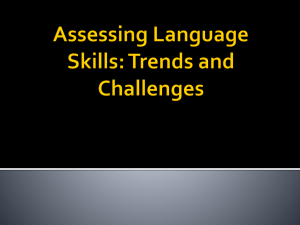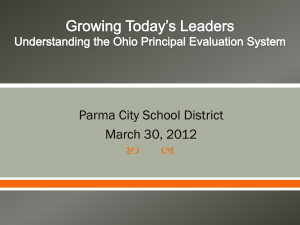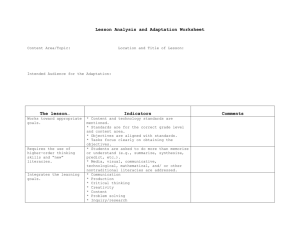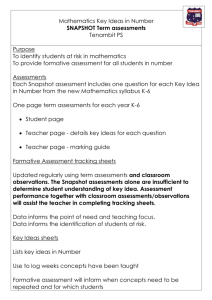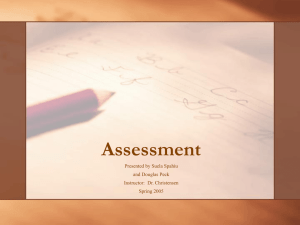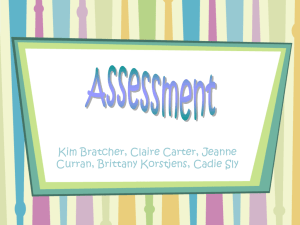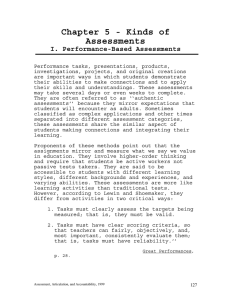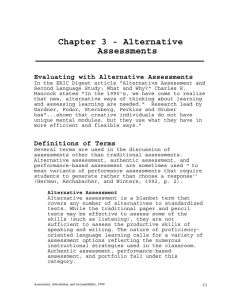Assessment
advertisement
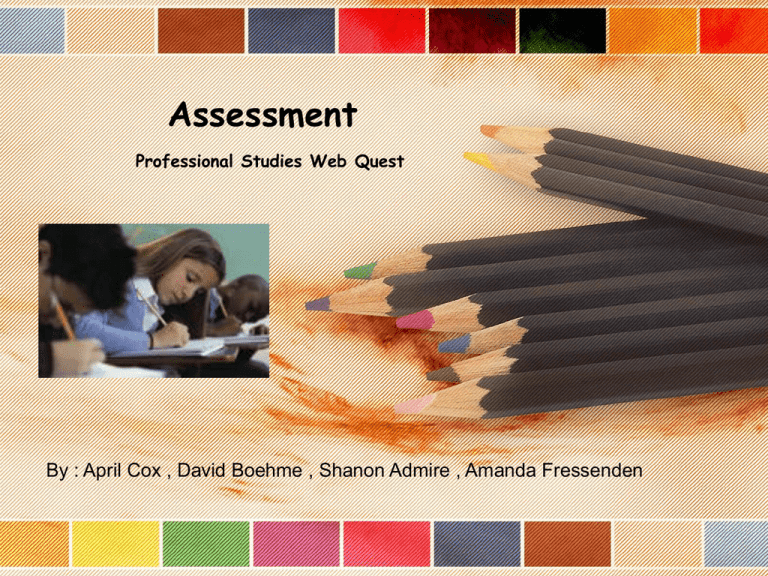
Assessment Professional Studies Web Quest By : April Cox , David Boehme , Shanon Admire , Amanda Fressenden Major types of Assessment • • • • • • • • • • Authentic Assessment Performance Assessment Traditional Assessment Self Assessment Group Work Assessment Summative Assessment Formative Assessment Subjective Assessment Formal Assessment Informal Assessment Examples of Assessment Graph Data Drawing a Chart Slide presentations Completing an Art Project Science Questions Researching Information Feedback Assessments Formative Assessments •Identify the expected accomplishments. • State the requirements of each accomplishment. • Describe how performance will be measured and why. •Set exemplary standards •Identify exemplary performers •Feedback about how well each person is performing •Backup information as needed to help people troubleshoot •Relate various aspects of poor performance to specific remedial actions. •On-going assessment or assessment for learning. •Information obtained through testing procedures must be modified for the learning activity to meet the students needs. •More like to motivate students to learn. •Collection of self-assessments to summarize the learning of the students. •Determine attributes of a good performance. •Provides information needed to adjust teaching and learning. Formal Assessments •Definition- The process examining student’s performance where it matches to the instructional goal. •Data which support the conclusion made from the test. •Checklist and charts •Curriculum-Based Measurement •Portfolio assessment •Provides a direct link between assessment and teaching. What is “ Authentic” Assessment ? • • • • • • • • • • • Direct method of measuring students performance Focus on processes and rationales that can be linked to knowledge Students construct open-ended responses to what they have learned. Develop responses rather than opinions. Higher order of thinking Demonstrate knowledge, and skills that are appropriate to the topic. Assessment based on getting a real-world demonstration to learning. Assessment of tasks that resemble reading and writing in the real world. Aligned with the curriculum and instructions. A “One-shot” Evaluation that quick complex decision are made based on the topic. Uses a Rubric to measure students’ work. Self-Esteem Assessment Aspects of a person’s life pinpoint the problems and benefits self-concept. Mistakes as failure or as opportunities to improve. “Self-concept”, “self-esteem”, “self-worth, and “self-acceptance” are commonly interchangeable. Self-evaluations specific to different domains of behavior. Demand characteristics of self-needs, and technical assessment procedures. Self-discovery. Guided perspectives, decisions, and selfevaluation. What is “Performance” Assessment ? • Reflects real life task where a person applies their knowledge. • This type of assessment has may interferes with time constraints from the classroom lesson. • U.S. Congress, Office of Technology Assessment (OTA) defines Performance Assessment as “ testing methods that require students to create an answer or product that demonstrates their knowledge and skills.” • Encourage feedback in the classroom. • A well established Performance Assessment must provide active learning for culture diverse individuals. • A good high standards for reliability and validity must be meet. What is “Traditional” assessment? Test Performance for his or her peers performance. Interpret how that person’s performance compares to “norm” of individuals. Relies on students prior knowledge. Related to a persons perceptions and Values. Methods deal with a persons availability. Accurate Scoring. Good for recognition skills. Why do we use a rubric ? Scale set of criteria acceptable/ unacceptable performance. Three types of rubric are Holistic, Analytical, and Checklist. Holistic gives the student the big picture. Promotes student awareness. Clarifies specific terms. Improves students’ end product. Scoring guideline for judging students work performance. Scoring guideline for judging students work performance. thrill-oriented = impulsive thrill seekers, shy away from events that don't give that thrill relationship-oriented = social learning, may not like working independently, prefers group work The four types of Motivation learning-oriented = learn for the sake of learning, gaining knowledge, interruptions cause frustration Goal = oriented ,assessment teaches students to set reasonable goals and to assess their performance Assess motivation In Classroom Assessment Techniques (Angelo & Cross, 1993) instructors can find numerous tools to help uncover their students' motivations for learning. For example, conducting a Course-Related Self Confidence Survey allows students to rate their self-perceived confidence in topics related to the course. The Focused Autobiographical Sketch can be used early in the course to help instructors determine how their students' past successes and failures may be related to their willingness to take on learning challenges which are important to the course. Tools like these can be valuable in looking for ways to modify curriculum and adjust teaching strategies that will allow the most success in their students' learning. (this is from wwwOSU.edu) Students are motivated by assessments when they know and understand what the assessment is for and about. If you know what you will be graded on, that is the project you work on. Assessment gives students motivation when they know the material, the subject is interesting to them, it's challenging and stimulates them. Intrinsic motivation vs extrinsic motivation Intrinsic is when students look for the knowledge in a lesson and are motivated by gaining it Extrinsic is when the students are more interested in getting the grade not gaining the knowledge If you can get the students attention, you can stimulate/motivated them. Conclusion IN CONCLUSION, THE DEFINITION OF ASSESSMENT IS TO JUDGE THE VALUE OR CHARACTER OF LEARNED FROM THE SITUATION. THERE ARE 10 MAJOR BASIC TYPES OF ASSESSMENTS USE BY PROFESSIONALS. THE USE OF FEEDBACK AND FEED FORWARD HELP GUIDE THE ASSESSMENT TO PROPER EVALUATION METHODS. FEEDBACK PROVIDES INFORMATION ON WHAT HAPPENS. WHERE AS FEED FORWARD GIVES SOMEONE SUGGESTIONS FOR THE FUTURE. FINALLY, ASSESSMENTS CAN BE USED NOT ONLY FOR CURRICULUM BASE BUT ALSO LABOR FORCES AND PRODUCTION OF GOOD AND SERVICES. Thank you ! References Self-Assessment http://edweb.sdsu.edu/people/Arospett/pie/Interventions/ selfassessment_1.htm http:www.nclrc.org/essentials/assessing/peerval.htm •Learning http://www.indiana.edu/idtheory/methods/mld.html •Self-concept http://www.ericdigest.org/1996-3/self.htm •Performance Assessment http://www.ericdigest.org/1996/creating.htm http://pareoline.net/getun.asp?V=6&h=2 http://performanceassessment.org/performance/index.html http://www.pgcps.org/elc/developingtasks.html http://wwwsedl.org/loteced/comparing_assessment.html •Feedback http://www.newhorizons.org/strategies/assess/wiggins.htm •Summative Assessment http://www.nmsa.org/publications/WebExclusive/Assessment/tabid/1120/Default.as px •Formative Assessment http://coe.sdsu.edu/ett/articles/formassess/start.htm Reference Continue •Reliability http://www.employment-testing.com/reliability.html http://fcit.usf.edu/assessment/basic/basicc.html •Authentic Assessment http://www.funderstanding.com/content/authentic-assessment http://searcheric.org/digests/ed334603.html http://www.eduplace.com/rdg/res/litass/auth.html •Informal Assessment http://scholastic.com/browse/article.jsp?id=4452 http://www.learner.org/workshops/tfl/session_07/practicel.html http://www.pawerc.org/foundationskills/cwp/view.asp?A=250&Q=12463 8 •Educational Assessment http://ache.cqu.edu.au/introduction.htm •Feedback http://www.newhorizons.org/strageties/assess/wiggins.h tm •Subjective Assessment http://www.usabilitynet.org/tools/subjective.htm •Feed Forward http://blogec.typepad/essential_connections/2007/10/try _feedforward.html http://www.hodu.com/employee_motivation3s.html •Osborne, Karen, Pearsons, Enid, Sheidlower, Anne D. (2001) Random House Webster’s Dictionary 4th Edition, NewYork, NY •Lemlech, Johanna Kasin. (2006) Curriculum and Instructional Methods for the Elementary Middle School 6th Edition, Upper Saddle River, New Jersey. Person Meril Prentice Hall
